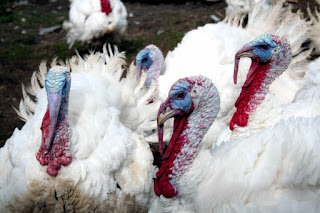- Turkeys belong to the genus Meleagris, which is native to the Americas. Not Turkey. The name turkey either originates from settlers in America mistaking wild turkeys for guinea fowl, which were imported via Constantinople, or because in Europe, turkeys were imported from the Americas via Turkey. So what do they call a turkey in Turkey? Hindi, meaning “India”. In French, the word for turkey is dinde "from India", and in Arabian countries, Russia and Poland, the word also suggests an Indian origin for the bird.
- The collective noun for a group of turkeys is a rafter. A male turkey is called a gobbler, a female is called a hen, and a baby turkey is called a chick, poult or turklette.
- How do you tell a male turkey from a female? The male is bigger and has Red, Purple, Green, copper, bronze, and gold feathers. They are the ones which make the gobbling sound. If all else fails, you can tell a turkey's gender from its poo. Males produce spiral-shaped poo and females produce poo shaped like a letter J.
- The turkey was sacred in ancient Mexican cultures. Mayans, Aztecs and Toltecs referred to the turkey as the ‘Great Xolotl’, viewing them as ‘jewelled birds’.
- A wild turkey can fly at up to 55 mph, although only for short distances. Domestic turkeys can't fly at all, because they've been selectively bred to be larger than their wild cousins.
- The bare skin on a turkey’s throat and head varies in colour depending on its level of excitement and stress. When excited, a male turkey’s head turns Blue, when ready to fight it turns red.
- The long fleshy object over a male’s beak is called a snood. Studies have shown that the health and reproductive success of a male turkey is linked to the size of its snood. A 1997 study in the Journal of Avian Biology found that female turkeys prefer males with long snoods and that snood length can predict the winner of a competition between two males.
- There are approximately 5,500 feathers on an adult wild turkey, including 18 tail feathers making up the tail fan.
- Part of the turkey’s stomach, the gizzard, contains tiny stones to help it digest its food.
- Benjamin Franklin is often said to have wanted the wild turkey to be the national bird of the USA, rather than the bald eagle; but one according to the Smithsonian's article on turkeys, he never actually proposed the turkey as the symbol, only praised it as being “a much more respectable bird” than the Bald eagle.
Tuesday, 25 December 2018
25 December: Turkeys
10 things you might not know about your Christmas dinner.
Subscribe to:
Post Comments (Atom)

No comments:
Post a Comment